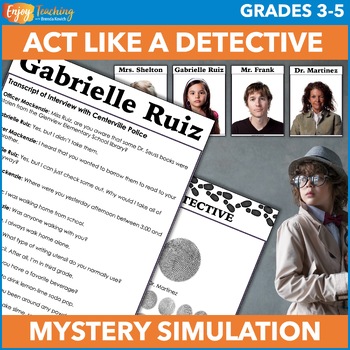Mock Crime Scene Investigation (CSI) Classroom Mystery/Detective Simulation Game
- PDF
- Google Apps™

What educators are saying
Also included in
- Five weeks of detective-themed ELA activities engage fourth and fifth grade students. The unit includes mystery reading, critical thinking, and writing projects; two novel studies; a simulation; posters and book report templates. A complete 25-day schedule guides instruction. Open the previews to taPrice $49.60Original Price $62.00Save $12.40
Description
Stage a mock crime scene investigation in your classroom! Kids solve the mystery through observation and science labs. They study crime scene photos, gather clues, analyze fingerprints, and experiment with powders and chromatography. Students love participating in this forensic science simulation - and cracking the case!
Open the preview to take a closer look at the game-like project.
The crime scene and detective activities are laid out for you. With a few common household items (such as pens, powders, and egg cartons), you can set up mock CSI experiments – and kids can solve the mystery!
- Introduce the mystery scenario. A set of Dr. Seuss books has been taken from the Glenview Elementary School library. Display the photo of the crime scene. Have students take notes on what they observe – and the investigation begins!
- Discuss suspects’ opportunity and motive. Display mug shots of the suspects. Have students read transcripts of police interviews and take notes.
- Look at objects on suspects’ desks and analyze their fingerprints. Objects on the desks associate them with specific clues. Fingerprints narrow the pool of suspects.
- Conduct the mystery powders lab in groups of four or five. At the end, you will provide attributes of the powder found at the scene of the crime.
- Do the chromatography activity. It will determine whose writing utensil was used to write the note. This helps them determine whodunit.
- Kids use clues and evidence to solve the case. The class debriefs, and you read “Case Closed” to summarize findings of the investigation.
Files provide all printable materials that you will need to set up your CSI activity:
- Crime scene photo - A set of Dr. Seuss books have been stolen from the Glenview Elementary School Library.
- Mug shots of suspects
- Photos of suspects' desks (with incriminating evidence, as well as red herrings)
- Transcript of suspects' interviews
- Note-taking sheets
- Fingerprint analysis
- Mystery powders lab
- Chromatography activity
- Case closed - news release to culminate mystery
- Answer keys
In addition, you will need materials for the powder and chromatograph labs in the simulation. Most are commonly found in classrooms and/or homes.
- 4 powders – flour, baking soda, baking powder, cornstarch
- 3 reactors – water, vinegar, iodine
- Egg cartons
- Small plates or paper towels
- Spoons
- Toothpicks
- Small containers
- Eyedroppers
- Coffee filters
- 4 short cups
- 4 pencils
- Scissors
- Tape
- 4 writing utensils – permanent black marker, washable black marker, black pen, pencil
Listen to what other educators are saying.
- “This was the PERFECT supplement to our reading/writing mystery unit! It really brought mystery and detective work into our classroom in engaging and meaningful ways. Thanks for this engaging product! I can't wait to use it again with another class. It was even engaging for my hard-to-reach reluctant learner! He asked me if we could do more work like this in the future.” – Brianna G.
- “The most fun and engaging learning activity for reading!!! My students loved it!” – Pamela A.
Enjoy teaching!
Brenda Kovich






